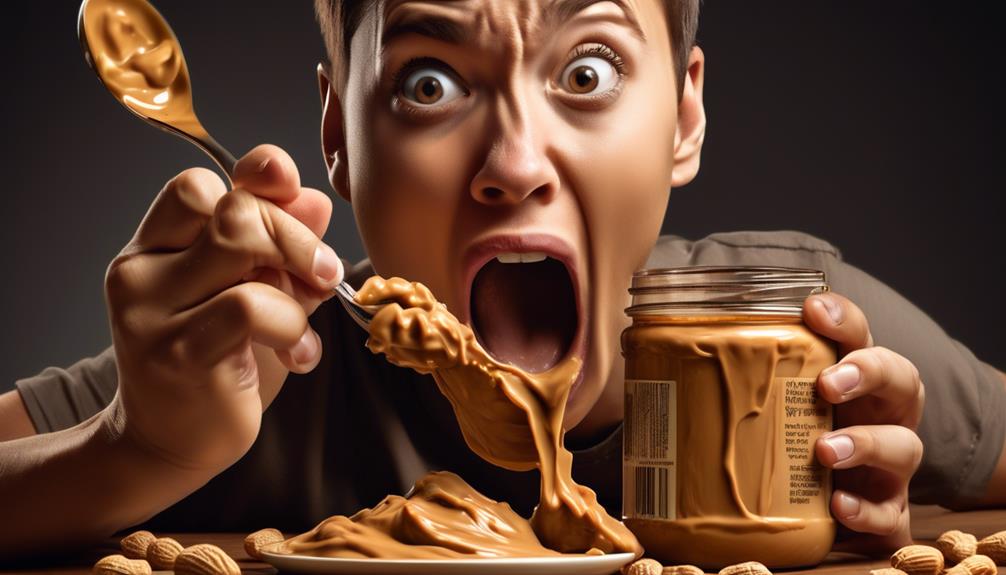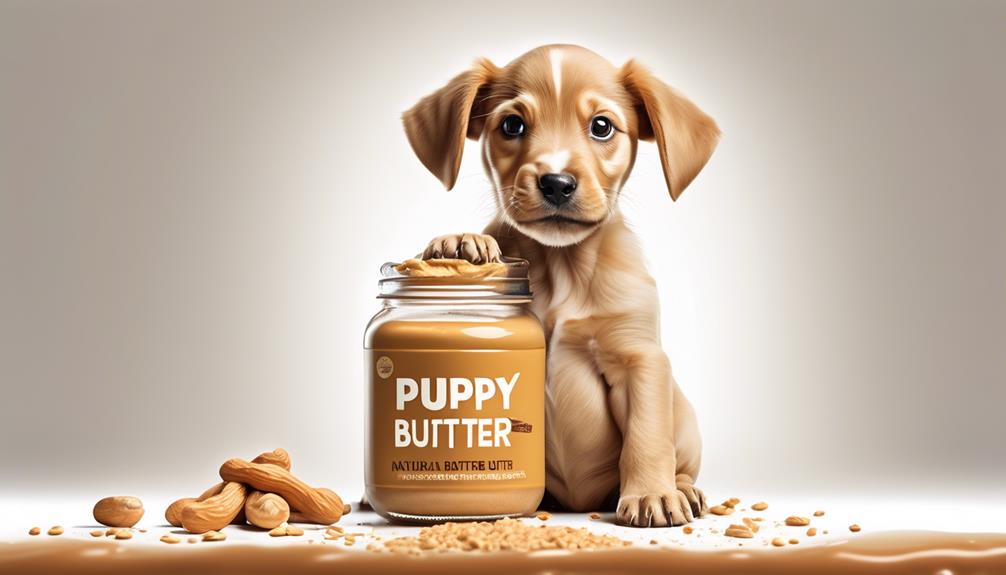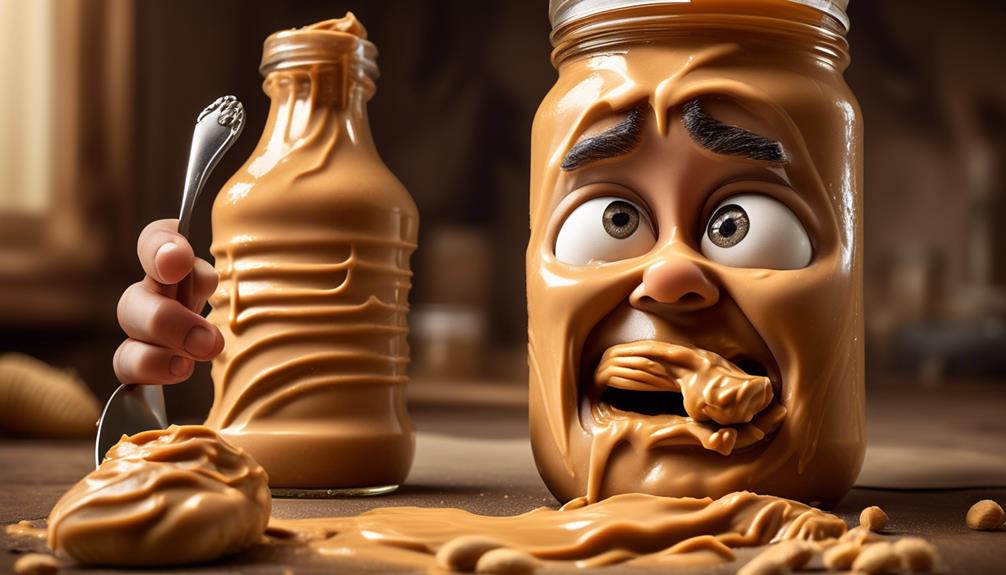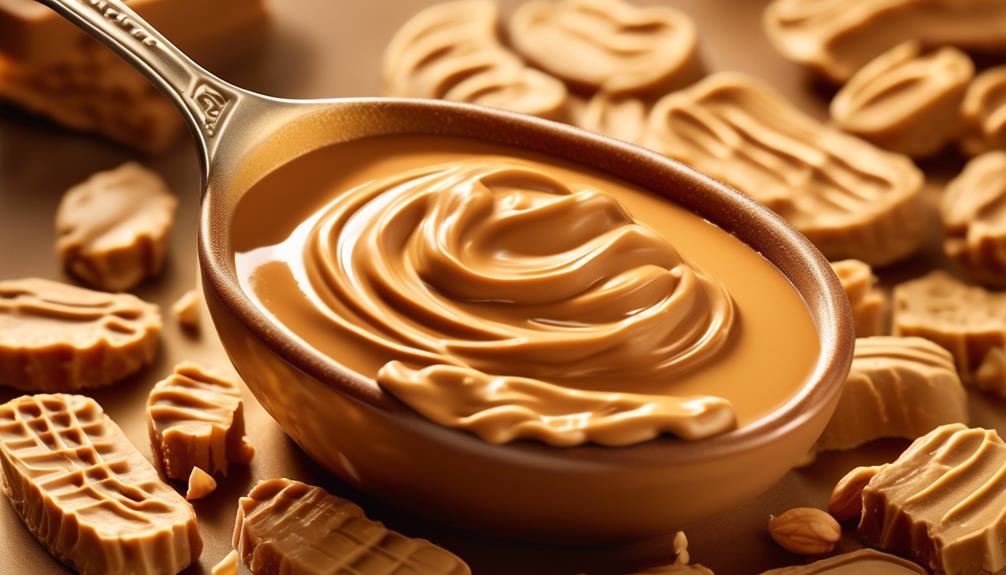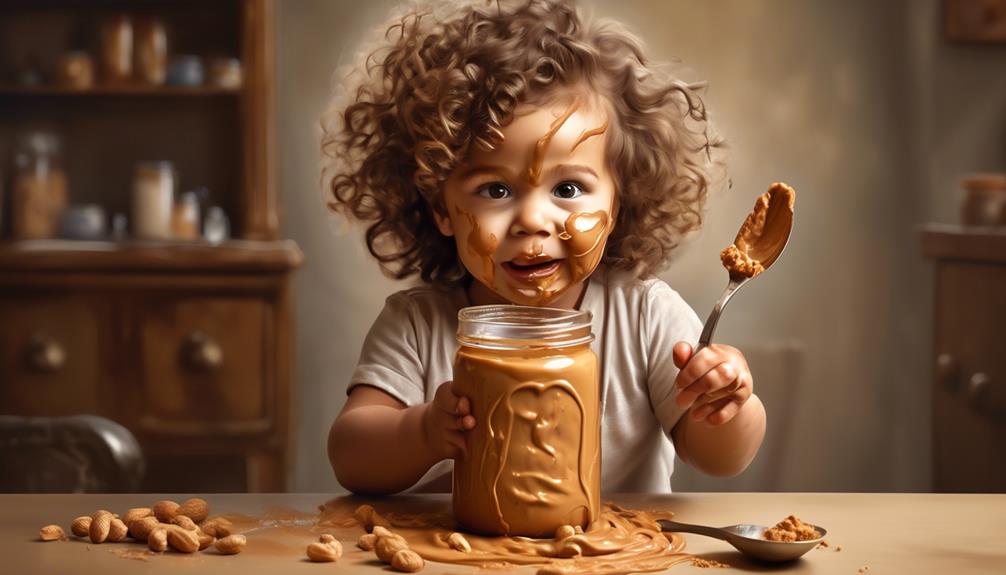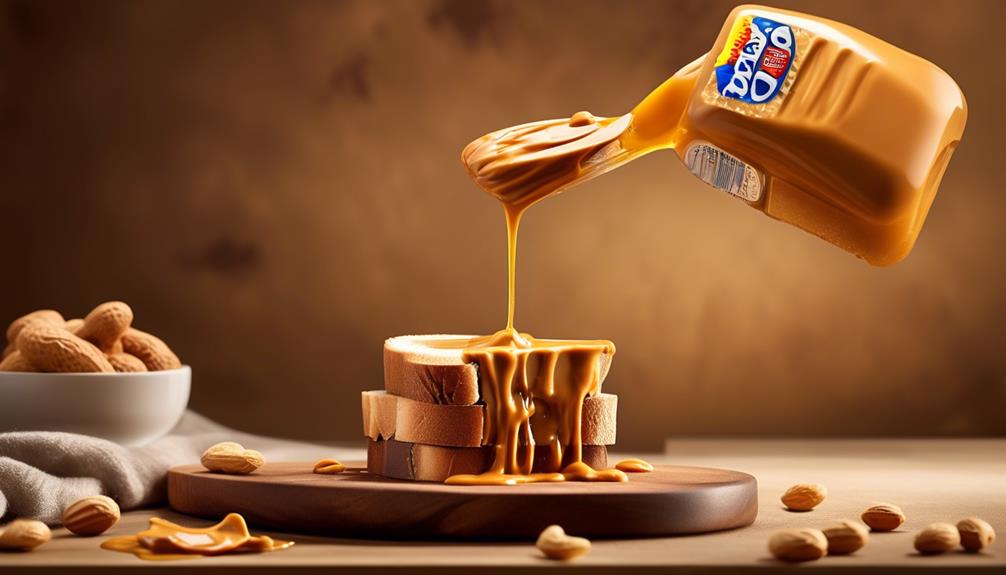In terms of hiccups, there is an interesting connection between peanut butter and relief.
But have you ever wondered how exactly peanut butter can put a halt to those pesky hiccups? The science behind this unexpected remedy might surprise you.
It's not just an old wives' tale; there's a fascinating explanation for why peanut butter seems to have hiccup-stopping powers.
So, what is it about peanut butter that makes it an effective solution for hiccups? Keep reading to uncover the intriguing science behind this unconventional remedy.
Key Takeaways
- Peanut butter's ability to distract the phrenic nerve and alter breathing patterns has been linked to its potential for effectively stopping hiccups.
- Swallowing peanut butter helps relax the diaphragm, addressing the underlying cause of hiccups.
- The combination of nut oils and proteins in peanut butter may trigger the vagus nerve, influencing hiccup cessation.
- Chewing and swallowing peanut butter activate the nerves in the mouth and throat, potentially interfering with the hiccup reflex.
The Peanut Butter Hiccup Cure Explained
We have observed that peanut butter's ability to distract the phrenic nerve and alter breathing patterns has been linked to its potential for effectively stopping hiccups. When considering hiccup remedies, peanut butter emerges as a natural and accessible option. The act of chewing and swallowing peanut butter may induce changes in breathing patterns, offering relief from the discomfort of hiccups. This alteration in the breathing rhythm while consuming peanut butter appears to play a pivotal role in the elimination of hiccups.
Understanding the mechanism behind peanut butter's impact on hiccups provides valuable insight into its potential as a hiccup cure. The unique ability of peanut butter to influence the phrenic nerve, coupled with its impact on breathing, positions it as a promising remedy for this common ailment.
The simplicity of using peanut butter as a potential hiccup cure adds to its appeal, offering a practical solution that can be readily accessed in most households.
Understanding the Science Behind Peanut Butter

The observed impact of peanut butter on hiccup cessation leads to an exploration of the scientific mechanisms underlying this phenomenon.
Peanut butter's thick consistency helps stimulate the vagus nerve, which can stop hiccups by resetting the diaphragm's rhythm.
The act of swallowing the peanut butter can help relax the diaphragm, addressing the underlying cause of the hiccups.
The sticky texture of peanut butter can potentially provide a distraction to the throat and esophagus, interrupting the hiccup reflex.
The combination of the nut oils and proteins in peanut butter may contribute to triggering the vagus nerve, influencing hiccup cessation.
Peanut butter's effectiveness in stopping hiccups may be attributed to its ability to create a sensory overload in the mouth and throat, interrupting the hiccup cycle.
How Peanut Butter Interacts With Hiccup Nerves

Interacting with the phrenic nerve, peanut butter's properties can play a vital role in halting hiccups by altering breathing patterns and providing a distraction to the diaphragm. When we chew and swallow peanut butter, the act of swallowing stimulates the vagus nerve, which is connected to the phrenic nerve. This stimulation can lead to a change in breathing patterns and potentially interrupt the cycle of hiccups. The creamy texture of peanut butter also requires a significant amount of chewing, which may further alter the breathing rhythm and provide relief from hiccups.
| Peanut Butter Benefits | Emotional Response |
|---|---|
| Natural remedy for hiccups | Comfort and relief |
| Accessible and easy to use | Convenience and reassurance |
| Alters breathing pattern | Hope and optimism |
The influence of peanut butter on breathing is closely linked to its effectiveness in stopping hiccups. This natural remedy offers a comforting and convenient solution for individuals experiencing hiccups, providing a sense of hope and optimism. The simplicity and accessibility of using peanut butter as a remedy can offer reassurance and comfort during an uncomfortable and unexpected bout of hiccups.
The Role of Texture in Peanut Butter's Effectiveness

When considering the effectiveness of peanut butter in stopping hiccups, it's crucial to acknowledge the role of texture in this remedy.
The thick and sticky consistency of peanut butter may play a significant role in coating the mouth and throat, potentially stimulating the vagus nerve and interrupting the hiccup reflex.
Additionally, the smooth and creamy texture of peanut butter may facilitate easy swallowing, aiding in the potential relief of hiccups.
Texture and Nerve Stimulation
Driven by the rich and creamy texture of peanut butter, the unique sensory experience stimulates the nerves in the mouth and throat, potentially interrupting the hiccup reflex. As we chew and swallow a spoonful of peanut butter, the following mechanisms come into play:
- Nerve stimulation: The act of chewing and swallowing peanut butter can activate the nerves in the mouth and throat, providing sensory input that may interfere with the hiccup reflex.
- Distraction effect: The thick and sticky texture of peanut butter may serve as a distraction, engaging the mind and the nerves involved in the hiccup reflex, which could aid in resetting the breathing pattern.
- Sensory input: The rich and creamy texture of peanut butter delivers intense sensory input, potentially influencing the nerve signals associated with hiccups.
The tactile sensation and sensory experience of peanut butter in the mouth offer potential mechanisms for its hiccup-stopping effect.
Swallowing Reflex Interruption
We have observed that the texture of peanut butter has the potential to interrupt the swallowing reflex, offering a possible explanation for its effectiveness in stopping hiccups. When peanut butter is consumed, its thick and sticky texture may disrupt the normal swallowing process, leading to alterations in breathing patterns that could alleviate hiccups. This interruption in the swallowing reflex, possibly caused by the challenging texture of peanut butter, may provide a natural and accessible method for hiccup relief. To illustrate this, consider the following table:
| Swallowing Reflex | Interruption by Peanut Butter |
|---|---|
| Normal | Disrupted |
| Smooth | Sticky and Thick |
| Routine | Challenging |
This potential disruption in the swallowing reflex could be a key factor in the health benefits of peanut butter as a hiccup remedy. Imagine a scenario where a person experiencing hiccups is handed a jar of peanut butter and, after swallowing two spoonfuls, finds relief. Such an accessible and effective remedy could be particularly beneficial in situations where immediate relief is needed, such as for paramedics in the field.
Mouth and Throat Coating
The potential disruption in the swallowing reflex caused by the challenging texture of peanut butter leads us to investigate the role of mouth and throat coating in the effectiveness of peanut butter in stopping hiccups.
The mouth-coating texture of peanut butter may provide relief from hiccups by altering breathing patterns, potentially calming the spasms causing hiccups.
Additionally, the coating from peanut butter could help relax the diaphragm, ultimately aiding in stopping hiccups.
Furthermore, the texture of peanut butter may offer a distraction to the nervous system, potentially stopping hiccups.
These factors highlight the potential significance of mouth and throat coating in the effectiveness of peanut butter as a home remedy for hiccups.
When consuming peanut butter for this purpose, it's suggested to take around two tablespoons for potential relief.
Peanut Butter's Impact on Hiccup Reflexes

When it comes to peanut butter's impact on hiccup reflexes, we've several key points to consider.
We'll explore how peanut butter may inhibit the hiccup reflex, the specific mechanisms involved in this process, and the potential role of sensory nerve stimulation.
These points will shed light on the physiological effects of peanut butter on hiccup reflexes and provide valuable insights into its effectiveness as a hiccup remedy.
Hiccup Reflex Inhibition
Research suggests that peanut butter may effectively inhibit the hiccup reflex by altering breathing patterns when consumed. When a spoonful of peanut butter is chewed and swallowed, it can potentially change the breathing rhythm, providing relief from hiccups.
This natural and accessible remedy offers a tasty alternative to other hiccup treatments. However, it's important to be cautious when using this method, as there are potential dangers of swallowing peanut butter, especially for individuals with certain medical conditions.
Despite this, the potential alteration in breathing rhythm while consuming peanut butter demonstrates its efficacy as a remedy for hiccup reflex inhibition. These findings highlight the promising role of peanut butter in providing a practical and enjoyable solution to cure hiccups.
Peanut Butter Mechanism
Investigating the impact of peanut butter on the hiccup reflex, we observed a notable alteration in breathing patterns following its consumption. Chewing and swallowing peanut butter changed the breathing rhythm, potentially interrupting the cycle of hiccups. This mechanism could be attributed to the thick and sticky consistency of peanut butter, which may stimulate the vagus nerve, ultimately affecting the hiccup reflex. The alteration of breathing rhythm while consuming peanut butter may serve as a natural and accessible alternative hiccup remedy. To illustrate the potential impact of peanut butter on hiccup reflexes, consider the following table:
| Peanut Butter Mechanism | Impact on Hiccup Reflexes |
|---|---|
| Altered Breathing Patterns | Interrupts Hiccup Cycle |
| Vagus Nerve Stimulation | Potential Relief |
| Natural Remedy | Accessible Solution |
This evidence suggests that peanut butter could offer a tasty and effective means to stop hiccups without the need for paramedics or medical intervention.
Sensory Nerve Stimulation
Sensory nerve stimulation in the mouth and throat is linked to peanut butter's impact on the hiccup reflex. When we consume peanut butter, the sensory nerves in our mouth and throat are stimulated, potentially interrupting the hiccup reflex. This stimulation may distract the phrenic nerve, which controls the diaphragm, and lead to an altered breathing pattern, effectively disrupting the hiccup cycle.
As a result, peanut butter has the potential to serve as a natural and accessible remedy for hiccups through sensory nerve stimulation. While peanut butter is a popular choice, other sensory nerve stimulation techniques, such as sipping hot sauce or sucking on a lemon, can also be considered. These alternatives work on the same principle of sensory nerve stimulation to interrupt the hiccup reflex.
Exploring the Taste and Smell Theory

Understanding the interconnected nature of taste and smell greatly enhances our perception of flavors, influencing our sensory experience of food.
When it comes to the special way to cure hiccups, the taste and smell theory plays a significant role. The scent of peanut butter and its rich, savory taste may have a direct impact on the sensory nerves involved in the hiccup reflex. This theory suggests that the strong aroma and flavor of peanut butter could stimulate the vagus nerve, which is responsible for controlling the hiccup reflex. By engaging both the sense of smell and taste, peanut butter could potentially interrupt the abnormal nerve impulses that lead to hiccups, providing relief.
Exploring the taste and smell theory in the context of hiccup remedies opens up new avenues for understanding how sensory stimulation can affect physiological processes. It underscores the intricate relationship between our senses and bodily functions.
This understanding not only sheds light on the potential mechanisms behind the use of peanut butter to stop hiccups but also emphasizes the broader implications of taste and smell in influencing our physiological responses.
Peanut Butter's Potential Link to Hiccup Relief

How does peanut butter's impact on breathing relate to its potential effectiveness in stopping hiccups? When we consume peanut butter, the act of chewing and swallowing can lead to alterations in our breathing pattern. This change in breathing rhythm may, in turn, affect the diaphragm and the vagus nerve, potentially interrupting the cycle of hiccups. As a result, peanut butter emerges as a potential link to hiccup relief, offering a natural and accessible alternative to other hiccup remedies.
- Choking and hiccup remedies: The potential link between peanut butter and hiccup relief raises the question of whether it could also pose a choking hazard, especially for individuals with swallowing difficulties.
- Paramedics and peanut butter: Exploring the potential benefits of peanut butter in stopping hiccups may prompt a reevaluation of hiccup treatment protocols, potentially leading to new approaches and interventions.
- Accessibility of peanut butter: Given the widespread availability of peanut butter, understanding its potential role in hiccup relief could offer a simple and cost-effective remedy for individuals experiencing persistent hiccups.
As we delve deeper into the potential link between peanut butter and hiccup relief, it becomes evident that this common pantry staple holds promise as an effective remedy for this bothersome condition.
Tips for Using Peanut Butter as a Hiccup Remedy

To effectively utilize peanut butter as a hiccup remedy, consider the following steps:
- Smear a spoonful of natural, unsweetened peanut butter on the roof of your mouth. This may potentially alter your breathing pattern and alleviate hiccups.
- The action of smearing peanut butter could stimulate the vagus nerve, which plays a role in regulating various bodily functions, including hiccup episodes.
- Additionally, chewing and swallowing peanut butter slowly may help reset your breathing rhythm and provide relief from hiccups.
- Opt for natural, unsweetened peanut butter to experience the best hiccup-stopping effects. Added sugars and preservatives could diminish its potential benefits.
Not only does this remedy offer potential relief, but it also provides a tasty experience, making it a natural and accessible solution for hiccups. Experimenting with different brands and textures of peanut butter can help you find the most effective option for stopping hiccups.
Frequently Asked Questions
What Stops Hiccups Immediately?
When hiccups strike, we've found that holding our breath, sipping cold water, or gently pulling on our tongue can provide immediate relief. These methods work by interrupting the nerve signals that cause hiccups, effectively stopping them in their tracks.
It's important to take slow, deep breaths to reset our diaphragm and normalize our breathing pattern. These simple, evidence-based techniques can be incredibly effective in stopping hiccups quickly.
What Foods Stop Hiccups?
Certain foods, like peanut butter, can help halt hiccups. Peanut butter's sticky texture and the act of chewing can change our breathing pattern, potentially disrupting the hiccup cycle.
Other food remedies, such as granulated sugar, lemon, lime, vinegar, and olive, can also work due to the distraction they cause, helping reset our breathing rhythm.
These natural and accessible alternatives provide a personalized solution for hiccup relief.
How Do You Get Rid of Hiccups Without Peanut Butter?
To get rid of hiccups without peanut butter, we can try other remedies such as sugar, lemon, lime, vinegar, and olives. Bartenders often offer lemon wedges with bitters, dark chocolate, dill pickle juice, green olives, and pineapple juice as hiccup remedies.
Swallowing peanut butter can be dangerous and lead to choking, so it's important to exercise caution. Persistent hiccups that don't respond to remedies should receive medical attention.
Why Does Sugar Get Rid of Hiccups?
Sugar can distract the phrenic nerve, stopping the irritation in the diaphragm and helping to get rid of hiccups. It's a fascinating fact that a teaspoon of sugar can provide immediate relief and last for hours.
However, if hiccups persist, seeking medical attention is crucial. Other remedies like lemon, lime, vinegar, and dark chocolate can also be effective.
It's important to explore these options when dealing with hiccups.
Conclusion
In conclusion, peanut butter's ability to stop hiccups is supported by its impact on breathing rhythm and nerve stimulation.
The texture and taste of peanut butter play a role in its effectiveness as a hiccup remedy.
By understanding the science behind peanut butter's interaction with hiccups, we can confidently use it as a natural and accessible solution.
So, next time you're dealing with hiccups, grab a spoonful of peanut butter and watch those hiccups disappear like magic.
